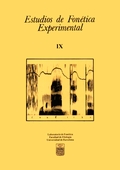Speaking rate effects in Catalan and English. A cross-language study
Abstract
Research on speech perception has provided growing evidence about the role of some context effects on speech perception. It has been proved that speaking rate influences such temporal parameters as VOT, causing an alteration of the perceptual mapping between acoustic signal and phonetic structure by shifting the boundaries between phonetic categories.
In this study we intended to find out the effects of speaking rate in the perception and production of /t/ in English and Catalan. The acoustic analysis of the production materials confirmed our prediction that both groups of speakers adjusted to speaking rate but in different ways. The English group varied the duration of VOT, whereas the Catalan group varied the duration of the closure interval. The length of both parameters increased in the slow rate and decreased in the fast rate.
The perceptual tasks performed by the two pilot subjects -one for each language- showed that there were no signs of a perceptual adjustment to speaking rate as it was found in previous literature. This lead us to suspect that maybe the perceptual adjustment to speaking rate takes place only at the boundaries between phonetic categories but not within the category. This would not be in accord with the findings of Miller and cols., in which they claim that the effects of context are not limited to the boundary region, but they extend to the centers of categories, resulting in a systematic shift in the location of the category's best exemplars or prototypes.
Downloads
Published
How to Cite
Issue
Section
License

This work is licensed under a Creative Commons Attribution-NonCommercial-NoDerivatives 4.0 International License.
All articles published online by Estudios de Fonética Experimental are licensed under Creative Commons Attribution-NonCommercial-NoDerivs 4.0 International (CC BY-NC-ND 4.0 DEED), unless otherwise noted. Estudios de Fonética Experimental is an open access journal. Estudios de Fonética Experimental is hosted by RCUB (Revistes Científiques de la Universitat de Barcelona), powered by Open Journal Systems (OJS) software. The copyright is not transferred to the journal: authors hold the copyright and publishing rights without restrictions. The author is free to use and distribute pre and post-prints versions of his/her article. However, preprint versions are regarded as a work-in-progress version used as internal communication with the authors, and we prefer to share postprint versions.




